Kaiju Wars review - a gigantically clever strategy spoof
Command & Kongquer.
Toss Into The Breach and Advance Wars into a nuclear reactor with the contents of an abandoned VHS store and you'll get Kaiju Wars - a brilliant turn-based strategy game about putting off the inevitable or preferably, taking it on an extended tour of the unpopulated warehouse district, well away from your town centre. The gist: giant movie monsters are attacking a series of violently coloured, isometric tile-based cities. Your job as Mayor is to keep them occupied till your chief scientist, the reassuringly hatchet-faced Dr Wagner, can cobble together a kaiju-repelling serum.
You can't beat the creatures through force of arms - even if you do successfully chisel away each kaiju's six health bars, they'll only retreat to their lairs for a few turns, sometimes emerging with bonus abilities. Rather, you're here to play a mixture of kaiju-bait and speed bump, misleading and inconveniencing the juggernauts while the boffins get on with the business of saving the world.
There are four types of kaiju in the game: a hairy cousin of Godzilla, an incredibly smug version of King Kong, a flying fire kaiju I call Brodan and a tunnelling snake kaiju who presently rejoices in the name of Sir Tuskawiggle, because I'm not quite sure which movie it's based on. Each has unique traits - Hairzilla likes fighting at sea, while Smug Kong is, of course, happiest on jungle maps - but they all share one weakness: predictability. The kaiju will always try to take out the nearest building, as indicated by a twitching red eye. Click on the Kaiju to see its path, with percentage odds of the monster moving to each individual square in the event of several possible routes. Once you have a sense of the Kaiju's route, you can introduce friction, lining up your valiant troops like thumb-tacks to erode its health and perhaps, slow it just enough to buy the target building an extra turn.
Units are distinguished by whether they attack airborne or ground-based kaiju, and by how much Counter damage they deal when stepped on. Needless to say, those units won't survive the process, so it's just as well they're so cheap - instantly redeployable for a fraction of the initial purchase cost, which allows you to shovel endless meat into the vast, angry sausage machine at your door. Well, as long as you have airbases, barracks and a few currency-producing buildings like offices to call on. You'll likely experience money troubles later in each battle once a certain map percentage is rubble, but the biggest downside to losing a unit is the time it takes to move reinforcements into position.
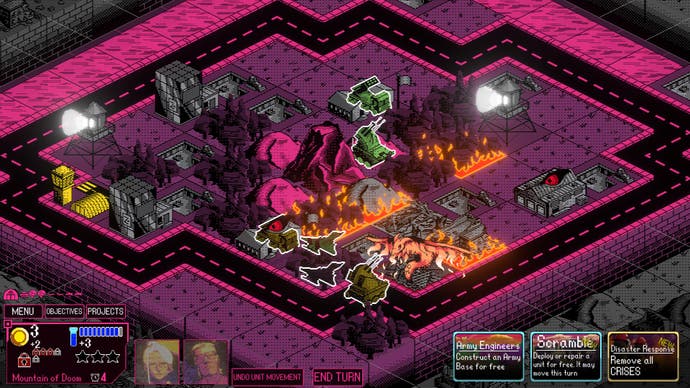
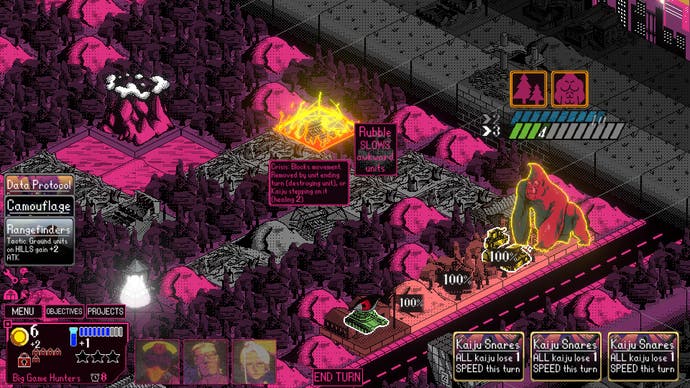
The most valuable buildings of all, of course, are the labs that cough up research points toward the anti-kaiju serum. The most valuable of these labs is the one housing Dr Wagner. As is often the case with mega-monsters, the Kaiju have mysterious human allies who are after the good Doctor's head. Each turn, these filthy, leviathan-loving traitors will implement Dark Project cards, which range from setting map squares on fire through unlocking kaiju mutations to black op hacks that reduce the security rating generated by your military infrastructure. If that security rating falls to zero, the kaiju's backers will locate Wagner's lab and sic the beast on it, forcing you to evacuate her to another lab, with all economic production postponed while she's in transit.
Fortunately, you can play special Project cards in turn. Dealt in groups of three each turn, these range from the basic yet vital - build another Lab, or restore three points of security - to the fancy and potentially tide-turning, such as prototype mecha fighters and army-wide upgrades. The card system is the key mutation in Kaiju Wars' transformation from lumbering asymmetrical tactics game into a series of wonderful, titan-themed puzzles, defined by the units and cards at your and the kaiju's disposal.
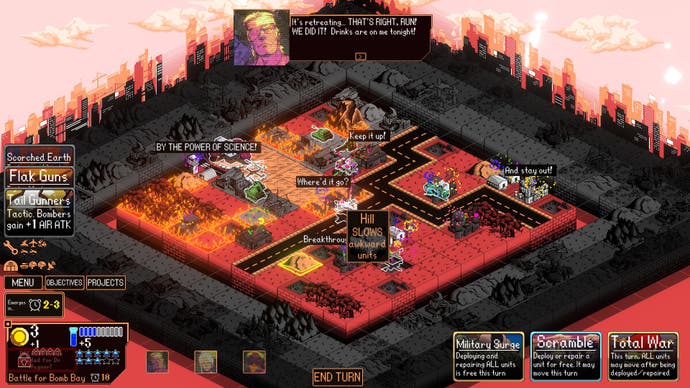

To give you a sense of the range, one mission pits you against Brodan in a heavily forested map. You've got AA guns to spare, but they only move one tile a turn over rough terrain, whereas Brodan can move up to six. The kaiju leaves a trail of burning tiles, not only threatening your units but also healing the monster when it doubles back on itself. So you must field bushplanes to douse the flames, while using a limited supply of airlift cards to shuttle defenders between distant buildings, trying to ground the kaiju so that your otherwise-useless bombers can pummel it.
Above all, Kaiju Wars has a wonderful feel for the cadence of a monster movie... What occasionally looks like a thin parody is, in fact, a labour of earnest affection for a species of story that, as with zombie movies, most nerds understand at the level of muscle memory.
Elsewhere, you must keep Hairzilla at bay with no army at all, luring the invader off by bolting together dummy bases around the map perimeter, while shadowing it with a radar truck to generate bonus research points. There are chapter-ending boss battles with a grueling research point quota in which the kaiju retreats every four turns, sometimes tagging in another kaiju and so, forcing you to reconsider your tactics. There are battles with special cards that let you clear ruined foundations and sneakily reconstruct labs once your adversary has waddled to the other end of a valley. Sometimes you must fight several kaiju simultaneously, which really throws the modest map proportions into punishing relief.
The cleverness of these potted puzzle labyrinths is, admittedly, spoiled a bit by the card system's element of randomisation. While battles do support different winning strategies, there is generally one optimal solution, and it's frustrating, having discovered that solution, when the luck of the draw hands victory to the kaiju in the closing moments. It's far from a deal-breaker, but it puts Kaiju Wars behind Into The Breach, where possibilities multiply relentlessly per turn and leave you thirsty to try again. You can, at least, bend the mission setups a little by way of Ace units, whose stats you can bolster between missions using victory medals - giving a missile truck the ability to counter attack, for example, so as to make it a viable defender. There are also bonus objectives (e.g. win in seven turns) and harder difficulties to encourage replay.
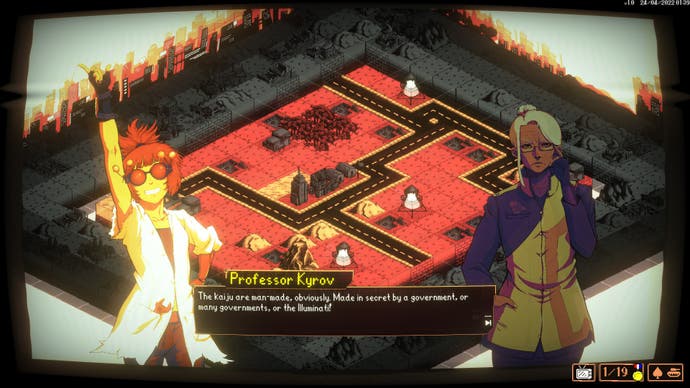
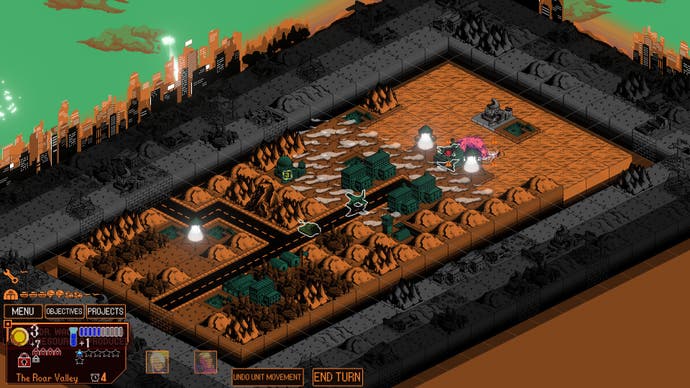
Kaiju Wars is an intriguing visual confection. On some level it wants to look as ramshackle as any B-movie, with event animations seemingly knocked together in Hypercard, and unit designs that might have been tipped out of a shoebox at a yardsale. The writing has fun with this - city residents yell that they can "see the wires" and the overarching story consists of clownish exchanges between eye-patched Kurt Russalikes and geeks in whitecoats. But it's also very striking, and elegant when you look closely - defined by electric primary-secondary colour combinations, with myriad neat touches like the way ocean tiles foam up into self-contained tidal waves when the kaiju emerge. It's got a real sense of swagger: map tiles fall into place at mission start like self-assembling type. For all the jokes about men in rubber suits, I was often reminded of swisher, meta-fictional kaiju movies like Godzilla: Singular Point.
Above all, though, Kaiju Wars has a wonderful feel for the cadence of a monster movie. It's always building towards those third-act reversals when your literally downtrodden cast of 16-bit expendables finally manages to break the creature's stride, your tanks ramming its ankles so that your experimental laser can rumble into firing range, in what feels exactly like the fruition of a desperate plan concocted in the back of a racing Humvee. What occasionally looks like a thin parody is, in fact, a labour of earnest affection for a species of story that, as with zombie movies, most nerds understand at the level of muscle memory. Forget sinister illuminati-style organisations - the kaijus' most fanatical adherents are surely the developers themselves.











